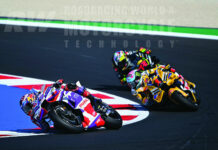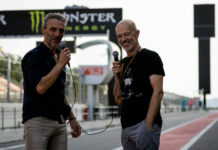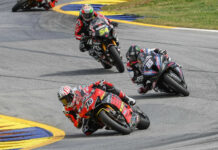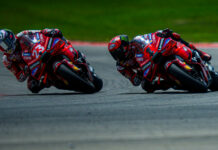Copyright 2003, Roadracing World Publishing, Inc.
First Person/Opinion
By David Swarts
Namco’s MotoGP 3 for Sony’s Playstation 2, the much anticipated follow-up to the company’s earlier two versions of the game, reached stores Wednesday, March 19 and looks to be another hit.
Motorcycle road racing fans and racers – all the way up to professionals who have admitted to using the game to learn unfamiliar international racetracks – have fallen in love with the incredible accuracy and realistic action of Namco’s MotoGP series of games, so it was only appropriate to do a review of the latest version.
MotoGP 3 updates the real FIM MotoGP World Championship line-up as of the 2002 season to include the new four-stroke 990cc machines, their colors, their sponsors, their sounds and their riders. Valentino Rossi and Tohru Ukawa are on the new V5 Honda RC211V, Max Biaggi and Carlos Checa ride the inline-four-cylinder Yamaha YZR-M1s, Kenny Roberts and Sete Gibernau push V4 Suzuki GSV-Rs to the limit and Regis Laconi tries to control the powerful Aprilia RS3 Cube Inline Triple.
Ignoring the real life mid-2002-season changes to four-stroke machines for some riders, Alex Barros and Loris Capirossi still ride the Sito Pons Honda NSR500, Daijiro Kato rides a Gresini Honda NSR500, Tetsuya Harada rides a Pramac Honda NSR500, Jurgen Van den Goorbergh rides a Kanemoto Honda NSR500, Norick Abe and Pere Riba ride D’Antin Yamaha YZR500s, Shinya Nakano and Olivier Jacque ride Tech 3 Yamaha YZR500s, Garry McCoy and John Hopkins ride WCM Yamaha YZR500s and Jeremy McWilliams and Nobuatsu Aoki ride the Proton KR3 Triples.
Five more current MotoGP tracks have been added to MotoGP 2’s 10 for a total of 15 accurately reproduced circuits in MotoGP 3. The new tracks added are the Czech Republic’s Brno, Portugal’s Estoril, Malaysia’s Sepang, Australia’s Phillip Island and the Spanish Valencia circuit. The Paul Ricard circuit in France is included in the game even though it is not a current 2003 venue, and the only 2003 MotoGP venues not reproduced in MotoGP 3 are Rio’s Nelson Piquet circuit and the South African track Phakisa Freeway. The changes to the real life Suzuka Circuit for 2003 have not been added to MotoGP3.
Another 20 “fantasy” tracks, meaning they do not represent a real racetrack, are included for fun and for use in some of the 100 new Challenges, making a total of 35 different courses in the new game.
The Legends line-up has also changed, allowing players to race against Kevin Schwantz, Mick Doohan, Wayne Rainey and Wayne Gardner. Some legends like three-time 500cc World Champion Kenny Leroy Roberts have been sent back to retirement or the front office if you prefer.
Playing the new game is very similar to MotoGP2, but MotoGP3 adds a first-person cockpit view that is realistic in that you can see the clip-ons moving back and forth, and the tachometer needle moves accurately. However, the fairing surrounding the windshield on the Yamaha YZR-M1, for example, blocks too much to use the cockpit point of view effectively, at least not at this early stage of playing the new game.
Among the instrument readouts displayed on the screen during normal views is a new “slipstream indicator” light, which has been added to the speedometer and is said to detect “slipstream conditions,” and horizontal line gauges indicating throttle and braking application force now sit at the bottom of the screen. Drafting is definitely possible on MotoGP 3 as I discovered while racing a friend on one of the fantasy tracks.
Most bikes power-wheelie much less in MotoGP 3, which is not entirely accurate of the 220-plus-horsepower four-strokes in real life, but intentional wheelies, stoppies, burnouts and victory poses are only a couple of buttons away. In addition, players can now, with advanced control settings, control the weight shift of the rider front-to-back (with the directional arrows or the left analog stick) and front and rear brakes independently. I did not have enough time to evaluate either of these new features, but the weight shift ability would be more realistic if the bike wanted to wheelie more, as in trying to put weight over the front end to keep it on the ground.
Also, in Season mode you can now adjust the amount of fuel your machine carries from one to 100 percent for each race. The manual claims, like in real life, that the machine will respond “slower” with a full fuel load and “easier” as the fuel is consumed during a race. A fuel gauge is not included among the instrument readouts, and if you run out of fuel during a race, you DNF.
A new Grand Prix selection has been added to supplement the VS (versus, one-on-one at one track) Multiplayer mode. In Grand Prix mode, two players can race for points in up to 15 rounds of variable lengths against a full grid of computer-controlled riders. And new for 2003, up to four players can race each other at the same time with Sony’s optional Multitap adapter; however, I would have to believe a very large monitor would be necessary to enjoy this application of the game.
Most of the existing features of MotoGP 2 remain with MotoGP 3 including different difficulty levels; Simulation on/off; automatic or manual transmission; machine adjustability including a choice between 16.5- and 17-inch tires; dry, wet or variable weather conditions and three Handicap levels that keep the racing close between riders of different skill levels.
After about 90 minutes of playing MotoGP3–hey, we’ve got a magazine to finish here–game play appears to be virtually identical to MotoGP2 with the aforementioned exception of the relative lack of power wheelies. It also appears as though the game has removed some capability of the 500cc two-strokes to make their performance relative to the more potent four-strokes. For instance, I could not use my same Suzuka brake markers riding Norick Abe’s Yamaha YZR500 on MotoGP3 that I could use riding the same machine on MotoGP2.
On the positive side, the literature accompanying the game claims the two-strokes and four-strokes have been re-calibrated for the player to feel the different weights of the machines. I could detect a slight difference in ease of turn-in and change of direction between the Yamaha YZR-M1 and the Yamaha YZR500 in my short test run. Also, riding the Honda RC211V I was able to see suspension action of the rear shock that helped predict the nature of rear-wheel slides. Also, the literature states that application of the rear brake can be used to control rear wheel spin.
The MotoGP 3 manual also includes a short description of each track and each of the 2002 MotoGP riders. So what does Namco have to say about our friend, young American John Hopkins? “John is the youngest MotoGP class rider in 2002. He has been involved in racing since the age of four, and his skill has earned him numerous titles. He entered the MotoGP class in 2002.”
In contrast, Pere Riba’s description reads, “Riba replaced the retired Alex Criville in 2002. He has steadily risen up the ranks, so his future in MotoGP looks promising.” Obviously, this text was written early in 2002.
The addition of the new four-stroke machines and updated rider line-ups to MotoGP 3 was mandatory, but I think reducing the bikes’ nature to power wheelie and the less-than-accurate reproduction of the new machines’ sounds are a bit of a letdown. If we can hear a distinct difference between machine sounds while listening to a tape-delayed satellite transmission of a live race from Europe, we should certainly be able to get more accurate sounds from a DVD connected directly to even the most basic television.
Those two low points aside, MotoGP 3 is a well-executed evolutionary improvement over MotoGP 2 just like the 2003 Yamaha YZF-R6 is to the 2002 Yamaha YZF-R6. MotoGP 3 takes what is already working and makes it slightly better, including subtly improved graphics, and adds new elements that will be appreciated by enthusiasts while not being intrusive to new fans’ enjoyment of the game.
If you already own the first two MotoGP games, you have probably already bought MotoGP 3. If you do not own a MotoGP video game but are reading Roadracingworld.com, what are you waiting for? MotoGP 3 by Namco is priced at $49.95 wherever most consumer electronics are sold and will most likely be the hottest topic of conversation in the AMA paddock at California Speedway.
Review: MotoGP 3 For Playstation 2
Review: MotoGP 3 For Playstation 2
© 2003, Roadracing World Publishing, Inc.






